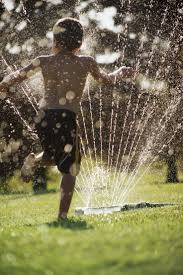
Be prudent. Many experts like Dr. Joseph Mercola and Dr Cannell of the Vitamin D Council agree that some sun exposure is a good way to get Vitamin D. Since the amount of exposure will be different for everyone depending on skin color, time of day and season, a safe place to start is to expose one’s skin to sunshine for 10-15 minutes per day with arms and legs exposed. (More on Vitamin D supplementation will be forthcoming in a future blog posting.) When the skin starts to get pink it’s time to get out of the sun.
And then what? According to the Environmental Working Group (EWG) there is no sunscreen safer than covering up with a long sleeve shirt, hat and sunglasses. And babies under 6 months old should not be exposed to sunscreen lotions at all. But many, especially children, can’t resist exposing their bodies once the weather warms up, and this is where healthy sunscreen comes in. The EWG has done all the research for us in this area. They have divided sunscreens into two groups: mineral-based and chemical-based.
The mineral based sunscreens are the safest in terms of lack of toxicity as the sun blocking agents are the minerals zinc or titanium which deflect the sun’s rays. They also offer the most extensive sun protection against both UVA and UVB rays. The downside is that the texture or white hue that they might impart may be objectionable to the user. The most recent formulations contain tiny particles of zinc and titanium, called nanoparticles, reportedly appearing more transparent than formulations of the past. I plan to do some extensive sunscreen slathering on myself and my family this summer so stay tuned here for our scientific findings.
The chemical-based sunscreens (containing oxybenzone) are just plain scary. Chemical sunscreens tout effectiveness against UVB rays which cause sunburning and tanning, but are not effective in blocking harmful UVA rays which are harder to detect as they don’t affect the color of your skin. A recent study by the US Centers for Disease Control (CDC) revealed that 97% of Americans are contaminated with the chemical oxybenzone which has been linked to allergies, hormone disruption and cell damage. As well, oxybenzone is linked to low birth weight in baby girls whose mothers were exposed to the chemical during pregnancy. To add insult to injury, oxybenzone is a “penetration enhancer” which means that it helps other chemicals penetrate the skin.
SPF is a measurement of sun protection from UVB rays. If your skin would burn after 10 minutes of sun exposure, a SPF 15 sunscreen would enable you to stay in the sun for 150 minutes (10 x 15) without burning. (A 30 SPF sunscreen would enable this person to remain in the sun for 10 x 30 = 300 minutes without burning.) An SPF can be misleading however as the rating does not take into consideration UVA rays which cause photoaging and cancer. Avoid sunscreens with an SPF higher than 50 as a higher number does not impart more protection. The American Cancer Society recommends that people use a sunscreen with an SPF of at least 15, the American Academy of Dermatology suggests an SPF of 30. More important than a high SPF is a generous application of sunscreen — most people never reach the SPF rating because they don’t put on enough sunscreen. The FDA recommends applying one ounce (about a palmful, or shotglass) evenly to all exposed skin.
Do you recognize your favorite sunscreen on this list? Each of these brands contain oxybenzone: Bull Frog, Banana Boat, Coppertone, Hawaiian Tropic, Neutrogena. Better choices are Alba Botanica, Badger, All Terrain, California Baby, UV Natural, Jason, etc. Please see EWG’s Sunscreen Guide for a complete list of safe and unsafe sunscreens.
I find it ironic that populations who live closer to the equator wear more clothing than we of northern climes. Because they are accustomed to living with sun every day and have a healthy respect for it they know how to protect themselves against it, as opposed to the binge mentality of the sun deprived. Personally, my sun strategy is to wear a big hat and a long-sleeve shirt with an SPF rating. I am the killjoy on the beach; I happily forego beach fashion to protect my skin. I have found that being covered is a better strategy for temperature control - if it’s breezy I have another layer, if the sun is particularly hot that day my skin stays cooler due to the fabric barrier. We are fans of SPF clothing in our family and everyone has a short or long sleeved rash guard for swimming, dry shirt for hiking and land activities, and a hat. Columbia has a great line of SPF clothing, as does REI, Land’s End, LL Bean, Sun Precautions and Coolibar. I am more relaxed knowing that my family is protected without having to be vigilant about sunscreen.
I urge you to take a look at the EWG sunscreen report and type in your favorite sunscreen to see where it falls on the spectrum. You will likely be surprised that a sunscreen you thought was safe is actually quite toxic. Throw away your leftovers from last year and start fresh this summer with a chemical-free sunscreen and hat. Healthy skin and peace of mind will be your reward.



